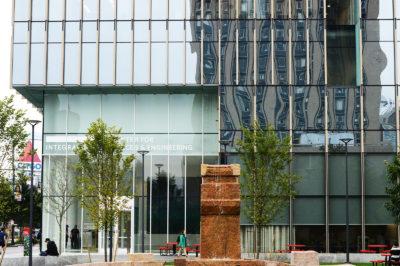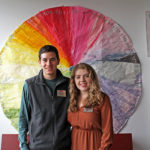
If you’re wondering about the new, shiny building in front of the College of Communication, it is the Center for Integrated Life Sciences and Engineering, which is set to officially open Sept. 14, according to BU Director of Research Communications Sara Rimer.
CILSE is a nine-story, state-of-the-art research facility where researchers from a variety of scientific fields and backgrounds will be working and collaborating on a wide range of projects, Rimer said. The building, located at 610 Commonwealth Ave., will be home to the Center for Systems Neuroscience, the Biological Design Center, the Center for Sensory Communication and Neuroengineering Technology and the Center for Cognitive Neuroimaging.
The building will also have 170,000 square feet of lab space where over 160 researchers and 270 graduate students, faculty, postdoctoral students and undergraduate research assistants will be working, according to Rimer.
CILSE Director of Operations Kevin Gonzales said the building’s construction cost over $100 million since breaking ground in the spring of 2015, and it was funded by BU’s capital budget. The research taking place in the building will be funded by various outside grants, he added.
Gonzales said that one of the building’s most notable new technologies is the Siemens 3 Tesla Magnetic Resonance Imaging scanner, which will have a home in the Center for Cognitive Neuroimaging.
“[The scanner] is an important part of the building because it allows BU researchers to conduct their scanning needs on campus without having to travel to other facilities or institutions,” Gonzales wrote in an email.
The National Science Foundation’s Major Research Instrumentation Program covered $1.6 million of the fMRI scanner’s $2.2 million price tag, Gonzales said.
Some researchers who will work inside the building said they are excited about the access to the fMRI scanner.
Tyler Perrachione, a researcher in the Communication Neuroscience Research Laboratory, said the fMRI machine will useful to him because it will allow his research to be done at BU instead of off campus at Harvard University and locations in Charlestown, for example.
“The fMRI is used to investigate what parts of the brain are activated by different kinds of things related to reading, like seeing letters or listening to sounds and understanding sentences,” Perrachione explained. “This would help us understand what we’re trying to get at, which is a basic biological mechanism that stands in the way of learning to read.”
Perrachione said that the CILSE building will be essential in bringing different disciplines of science together, which can help generate new ideas that could change the world.
“Bringing all these disciplines together is going to synthesize new ideas,” he said. “It’s going get people thinking about problems and thinking outside the box.”
Other BU researchers said that CILSE will be essential in allowing all types of students and researchers to collaborate.
Director of the Center for Systems Neuroscience Michael Hasselmo said one of the main goals in his role at the new facility will be to enhance collaboration between different researchers.
Hasselmo, who is also a professor in the Department of Psychological and Brain Sciences, researches the role of neuroscience and neural activity in creating memories.
“The new CILSE building provides an outstanding environment for our research, with excellent facilities for neurophysiological recording and analysis of experimental data,” Hasselmo wrote in an email. “It is a great improvement over previous research space that we have used.”
Many BU students also said they are looking forward to seeing how CILSE and its many features will aid BU researchers.
Greco Song is a graduate student studying biomedical engineering in the Boston area and spends time as a researcher at BU in the Tissue Microfabrication Lab. Song said he is excited to work at one of the labs because it will provide students and researchers more opportunities to collaborate.
“We have a lot of engineering in the building but also some people working on computer science, so it’s a really cool concept that we’re bringing everyone together in one building,” he said.
Andre Levan, a senior in CAS, said he thinks having the MRI machine and other technology on campus has the potential to increase BU’s status as a major research institution.
“BU has so many research labs spread out in such a big research institution,” Levan said. “Having more state-of-the-art technology and having it available right in our front yard to do research … is going to be very beneficial.”




